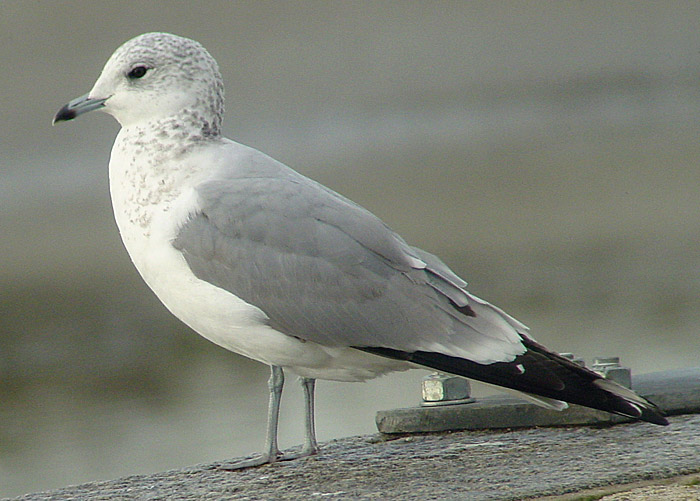 Mew Gull Larus canus canus; heinei; kamtschatschensis; brachyrhynchus
Mew Gull Larus canus canus; heinei; kamtschatschensis; brachyrhynchus
(last update: March 12, 2012)
Mew Gull canus 2cy, October 24 2002, Etaples / Boulogne-sur-Mer, France (50.42N,1.34E).

From June to October, a complete moult will bring birds in so-called "second winter" plumage. The head and hind-neck are strongly spotted and from the hind-neck, these spots form streaks, creating a collar running down the sides of the breast. Under-parts, tail-coverts and rump are white. The second generation primaries resemble adult primaries, but the black is more extensive in the outer-wing, with black sub-terminal markings down to P4 or even to P3. The greater and median primary coverts and the lesser coverts in the carpal edge are dark centred as well. The white tips on the outer primaries are ill-defined, wearing off quickly and the mirrors on P9 and P10 are smaller than in full adult plumage. The tail is normally all-white in race canus, although some individuals still show limited black markings. The iris is dark brown, the greyish bill has a clear black bill-band and the legs are still greyish as well.
After the complete moult in June to October, the American race brachyrhynchus may still show several immature feathers in the wing, contra the adult-like appearance of nominate canus. The central tertials and some of the tail-feathers may show dark immature centres (even creating some kind of a tail-band in some individuals). Immature features can also be found in the central greater coverts and in the carpal edge and can even be found on the upper-tail and under-tail coverts. These immature features are less often found in nominate canus, which show no vestiges of a tail-band from autumn 2cy onwards ("second winter" plumage and later). In this respect, brachyrhychus resembles Ring-billed Gull, L. delawarensis. From autumn 2cy onwards, the iris in brachyrhynchus may turn obvious pale.